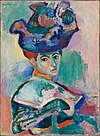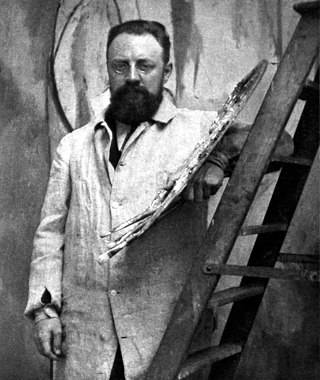
Henri Émile Benoît Matisse was a French visual artist, known for both his use of colour and his fluid and original draughtsmanship. He was a draughtsman, printmaker, and sculptor, but is known primarily as a painter. Matisse is commonly regarded, along with Pablo Picasso, as one of the artists who best helped to define the revolutionary developments in the visual arts throughout the opening decades of the twentieth century, responsible for significant developments in painting and sculpture.

André Derain was a French artist, painter, sculptor and co-founder of Fauvism with Henri Matisse.

Paul Victor Jules Signac was a French Neo-Impressionist painter who, with Georges Seurat, helped develop the artistic technique Pointillism.

Richard Diebenkorn was an American painter and printmaker. His early work is associated with abstract expressionism and the Bay Area Figurative Movement of the 1950s and 1960s. In the late 1960s he began his extensive series of geometric, lyrical abstract paintings. Known as the Ocean Park paintings, these paintings were instrumental to his achievement of worldwide acclaim.

Dance (La Danse) is a painting made by Henri Matisse in 1910, at the request of Russian businessman and art collector Sergei Shchukin, who bequeathed the large decorative panel to the Hermitage Museum, in Saint Petersburg. The composition of dancing figures is commonly recognized as "a key point of (Matisse's) career and in the development of modern painting". A preliminary version of the work, sketched by Matisse in 1909 as a study for the work, resides at MoMA in New York, where it has been labeled Dance (I).

The Young Sailor II is a painting by Henri Matisse from 1906. It is in the collection of the Metropolitan Museum of Art, in New York.

The Open Window, also known as Open Window, Collioure, is a painting by Henri Matisse. The work, an oil on canvas, was painted in 1905 and exhibited at the Salon d'Automne in Paris the same year. It was bequeathed in 1998 by the estate of Mrs. John Hay Whitney to the National Gallery of Art, Washington, DC.

The Conversation, a painting by Henri Matisse dating from 1908 to 1912, depicts the artist and his wife facing each other before a background of intense blue. It is in the collection of the Hermitage Museum in Saint Petersburg, Russia.
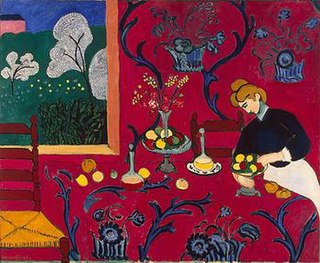
The Dessert: Harmony in Red is a painting by French artist Henri Matisse, from 1908. It is considered by some critics to be Matisse's masterpiece. This Fauvist painting follows the example set by Impressionism with the overall lack of a central focal point.

The Painter and His Model is a work by Henri Matisse painted late 1916, early 1917. It is currently in the collection of the Musée National d'Art Moderne, Centre Georges Pompidou, Paris. In this work Matisse depicted himself in his studio on the fourth floor of 19 Quai Saint-Michel, at work on his painting Laurette in a Green Robe (1916).
Purple Robe and Anemones is a 1937 painting by Henri Matisse featuring a woman wearing a purple robe sitting next to a vase of anemones.

Landscape at Collioure is an oil-on-canvas painting by French artist Henri Matisse from 1905. It is typical of his Fauvist style of the period. It is part of the collection of the Museum of Modern Art, in New York.

Window at Tangier; also referred to as La Fenêtre à Tanger, Paysage vu d'une fenêtre, and Landscape viewed from a window, Tangiers, is a painting by Henri Matisse, executed in 1912. It is held at the Pushkin Museum of Fine Arts, Moscow.

Fauvism is a style of painting and an art movement that emerged in France at the beginning of the 20th century. It was the style of les Fauves, a group of modern artists whose works emphasized painterly qualities and strong colour over the representational or realistic values retained by Impressionism. While Fauvism as a style began around 1904 and continued beyond 1910, the movement as such lasted only a few years, 1905–1908, and had three exhibitions. The leaders of the movement were André Derain and Henri Matisse.
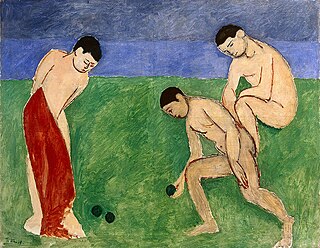
Game of Bowls is a 1908 painting by the French artist Henri Matisse. The painting shows three young men, probably Matisse's sons and nephew, playing a game of boules. Matisse sees the game as a manifestation of man's creativity, and an instrument to use in understanding the codes of life. The painting is part of Matisse's series on man's "Golden Age" and was part of Sergei Shchukin's collection before the October Revolution of 1917. It is now in the collection of The Hermitage, St. Petersburg, Russia.

Music is a wall-size painting made by Henri Matisse in 1910. The painting was commissioned by Sergei Shchukin, who hung it with Matisse's 1910 Dance on the staircase of his Moscow mansion. Matisse made the painting without any preparatory sketches, and thus the painting bears many traces of modifications. One can virtually trace the steps Matisse took to find the intended effect. As in Dance, the aim was to show man's attainment of a state of completeness by immersion in creativity.

Sergei Ivanovich Shchukin was a Russian businessman who became an art collector, mainly of French Impressionist and Post-Impressionist art.
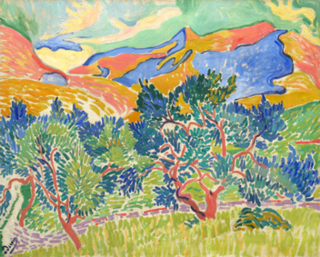
Mountains at Collioure is a 1905 painting by French painter André Derain. It was made while he was working with Henri Matisse at the fishing port of Collioure, in France. It has been in the National Gallery of Art in Washington, D.C. since John Hay Whitney, the previous owner, died in 1982. The work features long strokes of colours such as bright green, blue, mauve and pink. The entire scene is under a jade and turquoise sky.
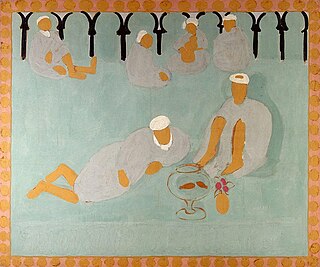
Arab Coffeehouse, is an oil-on-canvas painting by French visual artist Henri Matisse. Produced in 1913, Arab Coffeehouse was part of a series of goldfish paintings that Matisse produced in the 1910s and 1920s.



















